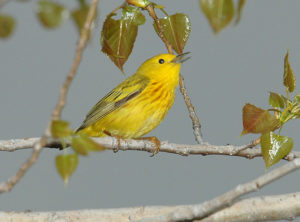Dear Front Range Birders:
Eight of us explored the Hudson Gardens environs until the ominous black clouds coming from the west were joined by a gusting breeze beginning to carry raindrops which hastened our return to the visitor center. So, we quit a bit prematurely but managed, before doing so, to have seen and/or heard 32 species (see list below).
Before sharing some of our highlights, I want to mention a couple of species that we did not see. Last year, by the end of June, we had a Wood Duck hen with six ducklings on the turtle pond. Today we saw no sign of any Wood Ducks, but we will hope to do so on our next walk on June 24. The other species that was conspicuously absent was Cooper’s Hawk. We’ve been extremely fortunate for several seasons now in getting to have views of a nesting pair of Cooper’s in the cottonwood grove just north of Nixon’s Coffee House by the bike path. This morning we saw neither hide, nor hair, nor feather of these guys. Again, we will be checking again in the future.
Now, as to this morning’s highlights, we had great views of a pair of Western Kingbirds foraging over the river on the plentiful insect fare, Yellow Warblers were numerous, a pair of Bullock’s Orioles were right above us in a cottonwood, and American Goldfinches were doing a lot of chasing one another around.
There were also numerous swallows in the air over the river just prior to the rain moving in.
I think the real highlight was getting to watch the efforts of a male Red-winged Blackbird trying time and again to chase a foraging Great Blue Heron away from what he considered to be his particular patch of cattails. The heron was hunting by slowly wading along the edge of the cattails, but the Red-wing would have none of it. Presumably there was a nest close by. The Red-wing would fly down at the head of the heron, and the heron would respond by lunging upward with open beak and without leaving its feet. This went on for quite sometime – a good drama, of which we did not see the outcome. As I explained at the time Great-Blues eat a variety of food items – essentially any living organism that they can grab including fairly large fish and muskrats.
Spring migration is coming to an end and many species are now on eggs or even starting to have fledglings. I hope you are managing to get out and enjoy the show.
Good birding!
Chuck
Hudson Gardens, May 27, 2017
32 species
Canada Goose (Branta canadensis) 4
Mallard (Anas platyrhynchos) 8
Double-crested Cormorant (Phalacrocorax auritus) 4
Great Blue Heron (Ardea herodias) 1
Eurasian Collared-Dove (Streptopelia decaocto) 2
Mourning Dove (Zenaida macroura) 3
Broad-tailed Hummingbird (Selasphorus platycercus) 2
Downy Woodpecker (Picoides pubescens) 1
Northern Flicker (Colaptes auratus) 3
Western Wood-Pewee (Contopus sordidulus) 2
Western Kingbird (Tyrannus verticalis) 2
Black-billed Magpie (Pica hudsonia) 1
American Crow (Corvus brachyrhynchos) 1
Northern Rough-winged Swallow (Stelgidopteryx serripennis) 4
Violet-green Swallow (Tachycineta thalassina) 5
Barn Swallow (Hirundo rustica) 1
Cliff Swallow (Petrochelidon pyrrhonota) 50
Black-capped Chickadee (Poecile atricapillus) 4
House Wren (Troglodytes aedon) 7
American Robin (Turdus migratorius) 5
Gray Catbird (Dumetella carolinensis) 1
European Starling (Sturnus vulgaris) 3
Yellow Warbler (Setophaga petechia) 8
Chipping Sparrow (Spizella passerina) 2
Song Sparrow (Melospiza melodia) 2
Red-winged Blackbird (Agelaius phoeniceus) 9
Common Grackle (Quiscalus quiscula) 12
Brown-headed Cowbird (Molothrus ater) 3
Bullock’s Oriole (Icterus bullockii) 2
House Finch (Haemorhous mexicanus) 5
American Goldfinch (Spinus tristis) 4
House Sparrow (Passer domesticus) 1





Comments
Write Comment